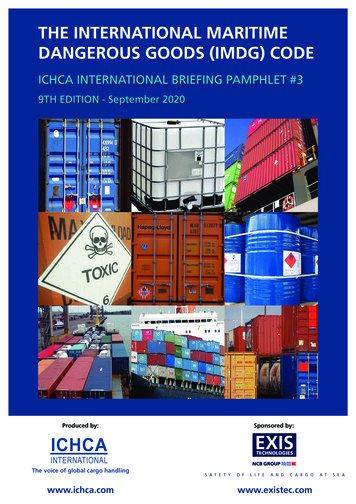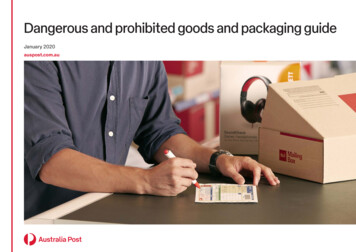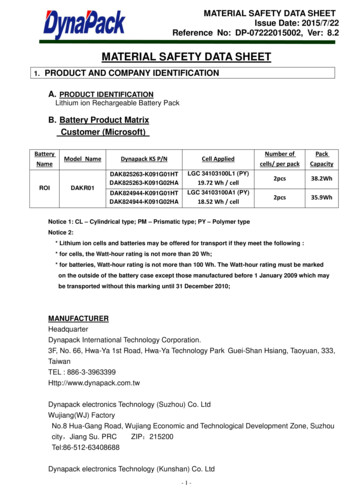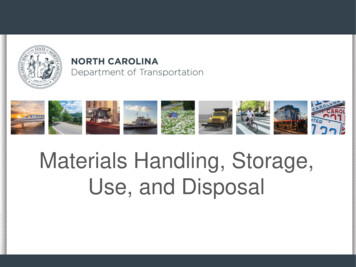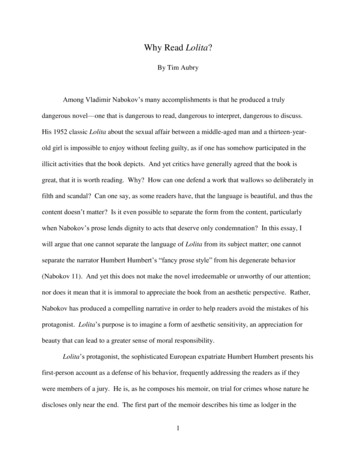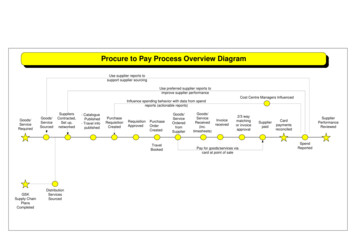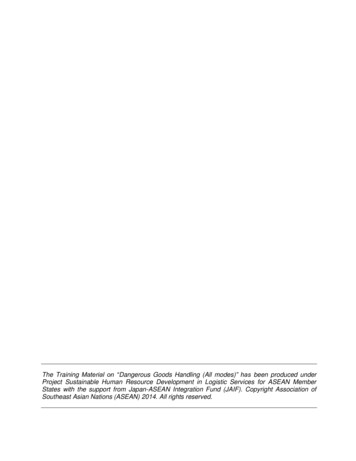
Transcription
The Training Material on “Dangerous Goods Handling (All modes)” has been produced underProject Sustainable Human Resource Development in Logistic Services for ASEAN MemberStates with the support from Japan-ASEAN Integration Fund (JAIF). Copyright Association ofSoutheast Asian Nations (ASEAN) 2014. All rights reserved.
Dangerous Goods HandlingChapter 4-2: IATA Dangerous Goods Regulations (IATADGR)Objectives 1.This chapter will cover the basic understanding on the applicable transport regulationby Air (IATA Dangerous Goods Regulations : IATA DGR)The Background, Development and Principles of IATA DGR will be explained.Sections of IATA DGR will be briefly elaborated.It covers Basic Hazard Classification and Hazard Communication under IATA DGR.The core element of the IATA DGR will be explained on how to read theinformation in Blue Pages (4.2 DG List)The Training Requirements under IATA DGR will be explained.The example of how to use IATA DGR will also be demonstrated.Introduction1.1 Background of IATA DGRTo provide procedures for the shipper and operator by which the articles andsubstances with hazardous properties can be safely transported by air on all aircommercial transport. In 1953, the Member airlines of IATA recognized thegrowing need to transport by air, article and substances having hazardous propertieswhich, if uncontrolled, could adversely affect the safety of the passengers, crewand/or aircraft on which they are carried.Most such articles and substances could be carried safely provided that they wereproperly packed and the quantities in each package were properly limited.1.2 Development of IATA DGRThe first version was published in 1956 as the IATA Restricted ArticlesRegulations, A Manual of Industry Carrier Regulations to be followed by all IATAmember airlines. The latest edition is 55th Edition with effective 1st January – 31stDecember 2014 published by the IATA Dangerous Goods Boards.Figure 4-2-1: IATA Dangerous Goods Regulations, 55 Edition (2014)Chapter 4-1 Page 2Oct 2014
Dangerous Goods Handling1.3 Principles of IATA DGRThe IATA DGR is an easy-to-use manual based on the International Civil AviationOrganization (ICAO) Technical Instructions for the Safe Transport of DangerousGoods by Air. It incorporates additional operational requirements, which provideharmonized system for operators to accept and transport dangerous goods safely andefficiently. It also includes a detailed list of individual articles and substancesspecifying the United Nations classification of each article or substance and theiracceptability as well as the conditions for air transport.1.4 Identification of Dangerous Goods by AirBasically Dangerous Goods when shipped by aircrafts can be mainly classified into4 types as below:1. Forbidden under any circumstances2. Forbidden under normal circumstances but may be carried with specific approvalsfrom the States concerned.3. Restricted to carriage on all cargo aircraft (CAO)4. Can be carried on passenger aircraft provided certain requirements are met.1.5 Packaging as Essential Component of DG TransportPacking Instructions (PI) are provided with a wide range of options (inner, outer,single packagings).Normally requires the use of UN performance-testedspecification packagings except when shipped in Limited Quantity (“Y” PackingInstructions). The quantity of dangerous goods permitted within these packaging isstrictly limited as to minimize the risk should an accident occur.1.6 Sections in IATA DGRLike other Dangerous Goods recommendations and regulations, The IATADangerous Goods Regulations have been structured and designed to be an easy-touse manual. It contains various sections as listed below:Section 1: ApplicabilitySection 2: LimitationsSection 3: ClassificationSection 4: Identification (Blue pages)Section 5: PackingSection 6: Packing Specifications and Performance TestsSection 7: Marking and LabellingSection 8: DocumentationSection 9: HandlingSection 10: Radioactive MaterialsAppendices A: GlossaryAppendices B: Nomenclature (symbols, units & conversion tables)Appendices C: Currently assigned Substances (Div 4.1& 5.2)Appendices D: IATA Members, Associate Members and other AirlinesAppendices E: Competent AuthoritiesChapter 4-1 Page 3Oct 2014
Dangerous Goods HandlingAppendices G: Related ServicesAppendices H: IATA Safety Standard ProgrammesIndexEach Section is further divided into numbered Subsections and paragraphs.1.3.3.2.1 raphTable 3.3A SectionSubsection1st )(3.3)(3.3A)1.7 Dangerous Goods Classification under IATA DGRClassification of Dangerous Goods in IATA DGR is purely based on the UN ModelRegulations and keeps being updated in every new edition. The Dangerous Goodsare classified into 9 Classes. Some classes are also sub-classified into Divisionswith Packing Groups.In order to give a quick review of 9 Classes of Dangerous Goods, following detailsonce again summarize all the 9 Classes and relevant division as below:Class 1: ExplosivesDivision 1.1: substances and articles which have a mass explosion hazardDivision 1.2: substances and articles which have a projection hazard but not amass explosion hazardDivision 1.3: substances and articles which have a fire hazard and either aminor blast hazard or a minor projection hazard or both, but not a massexplosion hazardDivision 1.4: substances and articles which present no significant hazardDivision 1.5: very insensitive substances which have a mass explosion hazardDivision 1.6: extremely insensitive articles which do not have a massexplosion hazardClass 2: GasesClass 2.1: flammable gasesClass 2.2: non-flammable, non-toxic gasesClass 2.3: toxic gasesClass 3: Flammable liquidsClass 4: Flammable solids; substances liable to spontaneous combustion; substanceswhich, in contact with water, emit flammable gasesChapter 4-1 Page 4Oct 2014
Dangerous Goods HandlingClass 4.1: flammable solids, self-reactive substances and solid desensitizedexplosivesClass 4.2: substances liable to spontaneous combustionClass 4.3: substances which, in contact with water, emit flammable gasesClass 5: Oxidizing substances and organic peroxidesClass 5.1: oxidizing substancesClass 5.2: organic peroxidesClass 6: Toxic and infectious substancesClass 6.1: toxic substancesClass 6.2: infectious substancesClass 7: Radioactive materialClass 8: Corrosive substancesClass 9: Miscellaneous dangerous substances and articlesThe numerical order of the classes and divisions is not that of the degree of danger.These 9 hazard classes have been established internationally by a United Nations(UN) committee to ensure that all modes of transport (road, rail, air and sea) classifydangerous goods in the same way.1.8 Hazard Communication under IATA DGRBasically the hazard communication for all 9 classes tends to be the same as otherregulations. However there are some special labels which are mainly used forinternational air transport of Dangerous Goods only.To clearly understand the strict consignment procedure, it is highly recommendedthat readers refer to the full text of IATA Dangerous Goods regulations whereasassuring that the proper IATA DGR training has been conducted and certified. Thischapter aims at giving a quick snapshot of comprehensive understanding and doesnot cover all detailed procedures in full compliance with IATA DGR requirements.The other additional handling labels in addition to hazard class labels are: Magnetized Materials Lithium Batteries Limited and Excepted Quantities Cargo Aircraft Only Environmentally Hazardous Substances Cryogenic Liquid Keep Away from Heat Time & Temperature Sensitive OrientationChapter 4-1 Page 5Oct 2014
Dangerous Goods HandlingFigure 4-2-2: IATA Dangerous Goods Hazard and Handling Labels1.9 Understanding the Blue Pages (4.2 Dangerous Goods List)This section of the IATA Dangerous Goods Regulations is commonly called “BluePages” due to the fact that its color is in blue. It can be easily identified by lookingat the side the text book. The actual part of this book is in fact called DangerousGoods List which is similar to all other regulations which is a core section inidentifying the substances and mixtures and relevant information in the regulations.Structure of Dangerous Goods List (DGL)The DGL is divided into 14 columns for each individual dangerous good listed.Much of the information contained in the DGL is coded to make it easier to presentin a table. The DGL is arranged in UN Number order; column 1. To look up anentry, the readers just need to have the UN Number.Column A – UN NumberContains the serial number assigned to the article or substance under United NationsClassification System. When this number is used, it must be prefixed by the letters“UN”.Column B – Proper Shipping Names (PSN)/DescriptonContains alphabetical listing of dangerous goods articles and substances identifiedby their proper shipping names together with qualifying descriptive text. The propershipping name is shown in bold (dark) type whereas the descriptive text is shown inlight type.Column C – Class or divisionContains the class or division number assigned to the article or substance accordingto the classification system described in Section 3. In the case of Class 1Explosives, the compatibility group is also shown.Chapter 4-1 Page 6Oct 2014
Dangerous Goods HandlingColumn D – Subsidiary RisksContains the class or division number of any important subsidiary risks.subsidiary risks are listed in numerical order.AllColumn E – LabelsContains the hazard label(s) to be applied to the outside of each package andoverpack for the commodity shown in Column B. The primary hazard label is listedfirst followed by any subsidiary risk label(s).Column F – Packing Group - contains the UN Packing Group (I, II, III) whereassigned to the article or substance.Column G – Passenger and Cargo Aircraft Limited Quantity – PackingInstructionsRefers to the relevant Limited Quantity (Y) Packing Instructions listed in Section 5for transport of the article or substance on a passenger or on a cargo aircraft. If nopacking instruction is shown, the article or substance cannot be carried underLimited Quantity provisions.Column H – Passenger and Cargo Aircraft Limited Quantity – Maximum NetQuantity per PackageShows the maximum net quantity (weight or volume) of the article or substanceallowed in each package for transport on a passenger or cargo aircraft. The weightquoted is net weight, unless otherwise indicated by a letter G which refers to thegross weight of the package.Column I – Passenger and Cargo– Packing InstructionsRefers to the relevant Packing Instructions listed in Section 5 for transport of thearticle or substance on a passenger or on a cargo aircraft.Column J – Passenger and Cargo Aircraft – Maximum Net Quantity perPackage – shows the maximum net quantity (weight or volume) of the article orsubstance allowed in each package for transport on a passenger or cargo aircraft.The weight quoted is net weight, unless otherwise indicated by a letter G whichrefers to the gross weight of the package.If the word “Forbidden” is shown, the article cannot be carried on a passengeraircraft.Column K – Cargo Aircraft Only– Packing InstructionsRefers to the relevant Packing Instructions listed in Section 5 for transport of thearticle or substance on a cargo aircraft ONLY.Column L – Cargo Aircraft Only – Maximum Net Quantity per Package –shows the maximum net quantity (weight or volume) of the article or substanceallowed in each package for transport on a cargo aircraft ONLY. The weight quotedChapter 4-1 Page 7Oct 2014
Dangerous Goods Handlingis net weight, unless otherwise indicated by a letter G which refers to the grossweight of the package.If the word “Forbidden” is shown, the article cannot be carried on any aircraft unlessexempted by States under the provisions of 2.6.1.Column M – Special Provisions – may show a single, double or triple digit numberpreceded by the letter “A”, against appropriate entries in the List of DangerousGoods. This alpha-numeric indicator relates to Subsection 4.4 and applies to all thepacking groups permitted for the entry concerned, unless the wording of the specialprovision makes it otherwise apparent.Column N – ERG Code – Emergency Response Drill Code as found in theInternational Civil Aviation Organization (ICAO) document “The EmergencyResponse Guidance for Aircraft Incidents Involving Dangerous Goods”. The codeconsists of a combination of letters and numbers, which represents suggestedresponses to incidents involving the specific dangerous good entry to which the drillcode is assigned.States and Operators VariationIn the IATA Dangerous Goods Regulations, there is certain limitation which mustmeet the strict compliance in two additional terms. The first one is countrylimitation which is so called States variation. The second one is airline limitationwhich is called Operators variation.States and Operators Variations entries in the List of Dangerous Goods are subjectto State and/or operator variations which must always be consulted. Variations areindicated in the appropriate locations in these Regulations and described inSubsection 2.9.1.10 How to use IATA DGRThe following table illustrates the step-wise approach how to easily use the IATADangerous Goods Regulations.StepStep 1Step 2Step 3Step 4Step 5Step 6Step 7Step 8Chapter 4-1 Page 8DescriptionDetermine the correct technical names andcheck if forbidden.Check if it is listed in Blue Pages (4.2) andidentify PSNIf not listed, determine class or division by itsknown propertiesIf properties are not known, test should be carried outIf it has multiple hazards, refer to Subsection3.10 and check if forbidden.Determine the most appropriate PSN of N.O.S. entriesIf small quantities, check DG in excepted quantitiesDesire to ship on passenger or cargo aircraftSection2.1 and 4.24.233.10, 2.1, 4.24.12.7Oct 2014
Dangerous Goods HandlingStep 9Step 10Step 11Step 12Step 13Step 14Step 15Step 16Determine the Packing Instructions Number (PI) andcheck applicable States & Operators VariationsPassenger aircraft (Column G & I)Cargo aircraft (Colum K & L)Determine the packing details in Section 5and special requirements in Section 1 & 4.Select method of packing from PI. Ascertain allcriteria are met.Ascertain all States and Operators Variations arefully complied.Ensure all appropriate markings and labellings areaffixed on the packagesComplete and sign Shipper’s Declaration forDangerous Goods (DGD) and prepare Air WaybillUse checklist to recheckOffer the complete consignment for transport by air4.2 and 2.94.15.0 and 62.9781.11 DocumentationThe shipper is responsible for providing information applicable to a consignment ofdangerous goods to the airline (operator) as described in section 8 of the IATADGR. The information may be provided by the completion of a Shipper’sDeclaration for Dangerous Goods in the IATA format of shipments containingdangerous goods as defined or classified in the IATA DGR, or, where an agreementexists with the airline, the information may be sent electronically by the use ofelectronic data processing (EDP) or electronic data interchange (EDI) techniques.The formats reproduced on the following pages are also shown in DGR Section 8and must be used for all shipments of dangerous goods. The form may be printed inblack and red on white paper, or in red only. The diagonal hatchings printedvertically in the left and right margins must be printed in red.The Shipper’s Declaration for Dangerous Goods (DGD)The explanation of each detail in the DGD is as below:1. Shipper : Full name and address of the shipper2. Consignee : Full name and address of the consigneeNote:There is no requirement that the names and addresses on the Air Waybill correspondwith those on the Shipper’s Declaration3. Air Waybill Number: The appropriate Air Waybill number for the shipment.This information may also be entered or amended by the shipper, his agent or by theairline or its handling agent.Chapter 4-1 Page 9Oct 2014
Dangerous Goods Handling4. Page of Pages: The appropriate page number of the total number of pagesof the Shipper’s Declaration for Dangerous Goods.5. Aircraft Limitations: Delete the box that does not apply to indicate whether theshipment is packed to comply with the limitations for passenger and cargo aircraftor cargo aircraft only. Where the Shipper’s Declaration is generated from acomputer system it is sufficient if just the applicable aircraft type is shown, i.e. onlyprint “Passenger and Cargo Aircraft” or “Cargo Aircraft Only”.6. Airport of Departure: Enter the full name of the airport or city of departure.This information may also be entered or amended by the shipper, his agent or by theairline or its handling agent.Note:This is information is optional and may be left blank.7. Airport of Destination: Enter the full name of the airport or city of destination.This information may also be entered or amended by the shipper, his agent or by theairline or its handling agent.Note:This is information is optional and may be left blank.8. Shipment Type (non-radioactive/radioactive): Where the Shipper’s Declarationis generated from a computer system it is sufficient if just the applicable shipmenttype is shown, i.e. only print “Non-radioactive” or “Radioactive”.9. Nature and Quantity of Dangerous Goods: Enter the identification of eachdangerous goods in the following order: UN number, proper shipping name, class/division, plus any subsidiary class ordivision which must be in brackets, packing group. e.g. UN 1738, Benzylchloride, 6.1 (8), II Followed by:o The total number of packages of the same type and content:o The type of packaging; ando The net quantity of dangerous goods in each package, or the grossweight of the completed package when applicable. For example: 5Fibreboard boxes x 10 kg, 1 Steel drum 20 L, 1 Wooden box 15 kgG.o The words “Overpack used” immediately after any entries relating tothe packages within the (each) overpack.Note:The units of measurement must be shown and must be SI (metric)units. Followed by:o The packing instruction number. Followed by:Chapter 4-1 Page 10Oct 2014
Dangerous Goods Handlingo The Special Provision number when required (A1, A2, A4, A5, A51,A81, A88, A99, A130, A190 and A191); and/oro Details of any government approvals or authorizations.10. Additional Handling Information: Enter any special handling informationrelevant to the consignments.11. Certification Statement: The Shipper’s Declaration must include thecertification statement and the air transport statement.12. Name and Title of Signatory: Enter the name and title of the person signing thedeclaration.13. Place and Date: Enter the place and date of issue.14. Signature: The declaration must be signed by the shipper.Figure 4-2-3: The Shipper’s Declaration for Dangerous Goods (DGD)1.12 Training RequirementsTraining must be provided or verified upon the employment of personnel identifiedin the categories specified in Table 1.5A in IATA DGR.Recurrent training must take place within 24 months of previous training to ensureknowledge is current, unless a competent authority has defined a shorter period.Chapter 4-1 Page 11Oct 2014
Dangerous Goods HandlingA test must be undertaken following dangerous goods training to verifyunderstanding of the regulations. Confirmation is required of successful completionof the test.Figure 4-2-4: Training Requirements under IATA DGR2.ConclusionShipping dangerous goods by air is a highly sensitive issue since it highly concernswith the lives of the passengers on the aircraft. Therefore, it is strictly importantthat relevant operators, shippers and freight forwarders are fully aware of the IATADangerous Goods regulations in details and have been adequately certified throughproper IATA DGR trainings.By reading this guidance document, it gives a quick snapshot of what relevantinformation is necessary in having the right understanding in arranging theDangerous goods shipments by air. It also gives a step-by-step approach as an easyto-use guideline and reference for quick learners only. In order to assure thatdangerous goods shipments by air are handled properly and safely in completecompliance with IATA DGR, it is a must that the IATA DGR must be completelyand strictly used as a full reference document.Chapter 4-1 Page 12Oct 2014
Dangerous Goods HandlingReferences1.2.Dangerous Goods Regulations (2014) Effective 1 January – 31 December 2014 Producedin consultation with ICAO 56th Edition. Montreal - Geneva: International Air ter 4-1 Page 13Oct 2014
The first version was published in 1956 as the IATA Restricted Articles Regulations, A Manual of Industry Carrier Regulations to be followed by all IATA member airlines. The latest edition is 55th Edition with effective 1st January - 31st December 2014 published by the IATA Dangerous Goods Boards.

